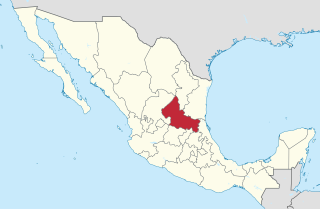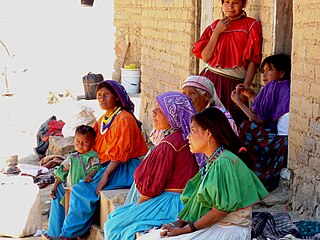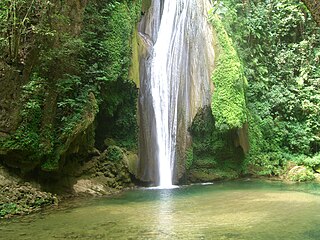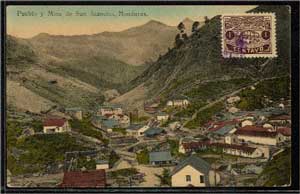La Luz Silver Project is a proposed mining venture in the Real de Catorce Desert, San Luis de Potosi, Mexico, by Canadian mining company First Majestic Silver.
The project has been met with opposition from groups including the Wixakari, or Huichol tribe, as well the Wirikuta Defense Front.
Wirikuta has been a sacred territory for the Wixarika people for thousands of years. Despite the 2008 of Hauxa Manaka pledging to protect it, at least 70 mining concessions have been granted in Wirikuta to First Majestic Silver, Revolution Resources and other mining companies since 2009. In February 2012, the Wixarika people obtained an injunction, stopping the mining project until a court case about cancelling the mining concessions concludes. [1] Before a gathering of approximately 60,000 people at Wirikuta Fest on May 26, 2012, First Majestic Silver announced it had returned some of their mining concession to the national mining reserve to protect Wirikuta, but the Wixarika Regional Council showed this to be false.

San Luis Potosí, commonly called SLP or simply San Luis, is the capital and the most populous city of the Mexican state of San Luis Potosí. It is the municipal seat of the surrounding municipality of San Luis Potosí. The city lies at an elevation of 1,864 metres. It has an estimated population of 824,229 in the city proper and a population of approximately 1,221,526 in its metropolitan area, formed with the neighbour city of Soledad de Graciano Sánchez and other surrounding municipalities, which makes the metropolitan area of Greater San Luis Potosí the eleventh largest in Mexico.

San Luis Potosí, officially the Free and Sovereign State of San Luis Potosí, is one of the 32 states which compose the Federal Entities of Mexico. It is divided in 58 municipalities and its capital city is San Luis Potosí City.

Potosí, known as Villa Imperial de Potosí in the colonial period, is the capital city and a municipality of the Department of Potosí in Bolivia. It is one of the highest cities in the world at a nominal 4,090 m (13,420 ft). For centuries, it was the location of the Spanish colonial silver mint. A considerable amount of the city's colonial architecture has been preserved in the historic center of the city, which - along with the globally important Cerro Rico de Potosí - are part of a designated UNESCO World Heritage Site.

Potosí is a department in southwestern Bolivia. It comprises 118,218 km2 with 823,517 inhabitants. The capital is the city of Potosí. It is mostly a barren, mountainous region with one large plateau to the west, where the largest salt flat in the world, Salar de Uyuni, is located.

The Huichol or Wixárika are an indigenous people of Mexico and the United States living in the Sierra Madre Occidental range in the states of Nayarit, Jalisco, Zacatecas, and Durango, as well as in the United States in the states of California, Arizona, New Mexico, and Texas. They are best known to the larger world as the Huichol, although they refer to themselves as Wixáritari in their native Huichol language. The adjectival form of Wixáritari and name for their own language is Wixárika.

Peñoles is a subsidiary company owned by Grupo BAL. Peñoles is the second largest Mexican mining company, the first Mexican producer of gold, zinc and lead and the world leader in silver production. Peñoles is a company with active mines within Mexico and with some prospection projects in South America. Holdings includes the Fresnillo Silver Mine / Mina Proaño, the Met-Mex Peñoles metallurgical complex and Química del Rey; a Chemical facility; three operations. Peñoles produces about 80,500,000 troy ounces (2,500,000 kg) of silver and 756,100 troy ounces (23,520 kg) of gold annually. Other metals that the company produces are zinc, lead, copper, bismuth, and cadmium.

Wirikuta is a desert, sacred to the Wixárika (Huichol) Indians high in the mountains of central Mexico, between the Sierra Madre Oriental and the Zacatecas ranges, near Real de Catorce. In Wixárika cosmology, the world was believed to have been created in Wirikuta.

The Sierra Gorda is an ecological region centered on the northern third of the Mexican state of Querétaro and extending into the neighboring states of Guanajuato, Hidalgo and San Luis Potosí. Within Querétaro, the ecosystem extends from the center of the state starting in parts of San Joaquín and Cadereyta de Montes municipalities and covering all of the municipalities of Peñamiller, Pinal de Amoles, Jalpan de Serra, Landa de Matamoros and Arroyo Seco, for a total of 250 km2 of territory. The area is extremely rugged with high steep mountains and deep canyons. As part of the Huasteca Karst, it also contains many formations due to erosion of limestone, especially pit caves known locally as sótanos. The area is valued for its very wide diversity of plant and animal life, which is due to the various microenvironments created by the ruggedness of the terrain and wide variation in rainfall. This is due to the mountains’ blocking of moisture coming in from the Gulf of Mexico, which generally makes the east side fairly moist and the west semiarid scrub brush. Most of the region is protected in two biosphere reserves, with the one centered in Querétaro established in 1997 and the one centered in Guanajuato established in 2007. The Sierra Gorda is considered to be the far west of the La Huasteca region culturally and it is home to the Franciscan Missions in the Sierra Gorda of Querétaro World Heritage Site.

Real de Catorce, often shortened to Real, is a village in the Mexican state of San Luis Potosí and the seat of the municipality of Catorce. It is located 160 miles (260 km) north of the city of San Luis Potosí, and currently has a full-time population of under 1,000 residents. This 'ghost-town' in the high and dry expanses of northern San Luis Potosí state was once a thriving silver mining settlement. Real de Catorce has long been a pilgrimage site for both local Catholics and Huichol shamanists, and is now being discovered by international tourists drawn by the desert ambience and reputed spiritual energy.

The New York and Honduras Rosario Mining Company (NYHRMC), known as Rosario Mining Company, was an American-owned corporation that owned and operated the Rosario mine, a gold and silver producer in central Honduras and Nicaragua.

Cerro de San Pedro is a village and seat of the municipality of Cerro de San Pedro, located in the Mexican state of San Luis Potosí in central Mexico. It is located in hills, 5 kilometres (3.1 mi) northeast of the city of San Luis Potosí.

XHEWA-FM/XEWA-AM are commercial radio stations in San Luis Potosí City, San Luis Potosí, Mexico. XEWA broadcasts on 540 AM and is a Class A station. Its transmitter is in Soledad de Graciano Sánchez. XEWA is one of the highest powered radio stations in North America, broadcasting at 150,000 watts, using a directional antenna by day and a non-directional antenna at night. 540 AM is a Mexican and Canadian clear-channel frequency.

The San Cristobal mine in Lipez, Potosí Department, Bolivia is an open-pit silver, lead and zinc mine near the town of San Cristóbal, Potosí. The mine, operated by Sumitomo Corporation, produces approximately 1,300 metric tons of zinc-silver concentrate and 300 tons of lead-silver concentrate per day, as of August 2010, by processing 40,000 to 50,000 tons of rock. It is one of Bolivia's largest mining facilities and, according to Sumitomo, the world's sixth-largest producer of zinc and third-largest producer of silver. It is located in southwestern Bolivia and hosts approximately 450 million ounces of silver and 8 billion pounds of zinc and 3 billion pounds of lead contained in 231 million tonnes of open-pittable proven and probable reserves. As the ore body is open both at depth and laterally, reserve expansion potential is considered excellent. The mine has been in various stages of development since the early 1980s but only recently came into full operation.
Minera San Xavier is a subsidiary of the Canadian company New Gold Inc. that operates a gold and silver mine near Cerro de San Pedro, a municipality of San Luis Potosí just 12 kilometers away from the capital city of the state. The city of San Luis Potosí was founded after gold was discovered in the hills near Cerro de San Pedro in the 15th century.
Cedral is a town and municipality in the Mexican state of San Luis Potosí in central Mexico. As of the year 2020, it has a total population of 19,840.

First Majestic Silver Corp. is a Canadian silver-mining company that operates in Mexico and the United States. It has four producing mines under its control: San Dimas Silver/Gold Mine, Santa Elena Silver/Gold Mine, La Encantada Silver Mine, and Jerritt Canyon Gold Mine. First Majestic also produces and sells its own bullion rounds and bars.

The Vochol is a Volkswagen (VW) Beetle that has been decorated with traditional Huichol (Wirrárika) beadwork from the center-west of Mexico. The name created by José Jaime Volochinsky is a combination of “vocho”, a popular term for VW Beetles in Mexico, and “Huichol”, the common name of the Wirrárika indigenous group. The project was sponsored by agencies associated with the Museo de Arte Popular, Mexico City, the states of Jalisco and Nayarit and other public and private organizations. The Volkswagen was covered in 2,277,000 beads applied by eight artisans from two Huichol families in an exclusive design based on Huichol culture.

The Sistema Público de Radiodifusión del Estado Mexicano until 2014, is an independent Mexican government agency. Its mission is to support the development of public broadcasting in the country and expand its coverage. It carries out this goal through ownership of a nationwide network of transmitters and the management of its own public television channel, Canal Catorce. It also owns four radio transmitters.
XHPEM-FM is a radio station serving Tayoltita, San Dimas Municipality, Durango and owned by Desarrollo Comunal Sustentable, A.C., an arm of the San Dimas silver and gold mine owned by First Majestic Silver. It broadcasts with 5 watts ERP on 100.7 MHz.
Omar Torrijos Herrera is a district in the Panamanian province of Colón, located approximately 115 kilometres (71 mi) west of Panama City. It is named after Omar Torrijos, de facto leader of Panama from 1968 to 1981.